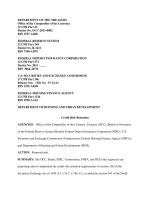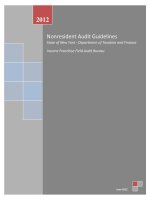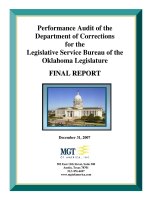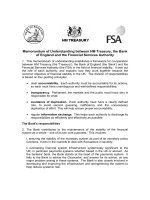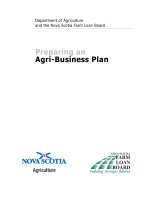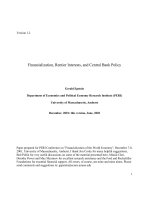Department of Agriculture and the Nova Scotia Farm Loan Board: Preparing an Agri-Business Plan pot
Bạn đang xem bản rút gọn của tài liệu. Xem và tải ngay bản đầy đủ của tài liệu tại đây (292.44 KB, 40 trang )
Department of Agriculture
and the Nova Scotia Farm Loan Board
Preparing an
Agri-Business Plan
building str onger futures
NOVA SCOTIA
BOARD
FARM
LOAN
TABLE OF CONTENTS
THE BUSINESS OVERVIEW 1
MARKETING PLAN 9
HUMAN RESOURCES PLAN 15
PRODUCTION PLAN 20
FINANCIAL PLAN 23
GLOSSARY OF BUSINESS FINANCE TERMS 31
Department of Agriculture Nova Scotia Farm Loan Board Page
1
Preparing an
Agri-Business Plan
Planning for Profit
The Business Overview
Introduction
Why do you need a business plan?
A business plan allows you to create a business operation on paper and
manipulate and evaluate scenarios without the risk of investing a lot of
time and money. Dry run planning reduces the possibility of the venture
failing, by identifying your proposals, strengths and weaknesses, and
developing a plan of action to cope with them.
Financial institutions, business partners, and investors will all require that
you have a proper business plan to prove your ideas are viable and that
you have adequate knowledge of your chosen area of business.
Whether you are starting a new business, buying an existing one, or
expanding your present operation, a business plan will help you prepare
for the unexpected and help set the goals for your future business
success. There is no replacement for a well thought out business plan.
Be realistic in your projections, honest in your evaluations, and thorough
in your research.
Why do you want to operate an agri-business?
An overwhelming fondness for plants, animals and nature is not a
sufficient reason to want to own and operate an agri-business.
In business, your primary goal
is to make your company a
profit so it will be able to
survive and prosper.
Department of Agriculture Nova Scotia Farm Loan Board Page
2
Getting started in an agri-business will require the
following:
Î General knowledge of the agriculture industry.
Î Recognition of your business opportunity or advantage.
Î A market for your product and a thorough understanding of that
market.
Î Technical knowledge of crop production practices and/or livestock
production.
Î Financial resources to develop your operation.
Î The necessary business management skills.
Where do I get the information to prepare my business
plan?
To prepare a plan, you need to research your proposed business. The
following sources of information will be helpful in developing your plan:
Î Interviews With Other Producers
Î Extension Specialists
Î Personal Work Experience
Î Industry Consultants
Î Library Research
Î Trade Suppliers
Î Trade Magazines and Journals
Î Demographic Studies
Î Industry Associations
Î Newspaper Articles, etc.
Remember a plan is just a plan and must be continually adjusted to the
changing conditions of your business. If something is not working, adapt
it until it works.
Business Advisors (Informal Board of Directors):
These are people with specific areas of expertise useful to your business.
All business managers can take advantage of the resources and expertise
other specialists have to offer. The cost of this expert advice is moderate
when compared to the cost to your business of making uninformed
decisions. It has been well proven that a business will grow much faster
with the help of an experienced group of advisors.
Search out all the
expertise you require!
Department of Agriculture Nova Scotia Farm Loan Board Page
3
Industry Overview
The foundation of your business plan is your research or ground work.
Every idea or concept should be challenged to determine whether or not
it has a reasonable chance of success.
An assessment of pertinent issues for the
industry will enable you to develop a more
credible plan.
Consider these questions as you challenge your idea:
1. (a) Are there global or international issues that will affect my
business?
(b) Are there national or interprovincial issues that should be
focused on?
2. Are there regulations or restrictions that can positively or
negatively impact on my project?
3. Identify major trends affecting the industry.
Try to determine strengths, weaknesses, opportunities, and threats in the
industry that will impact on your agri-business.
What is a Business Plan?
A business plan is an effective management tool that outlines how you
intend to run your business. As a management tool, a business plan will
help you determine the goals you need to achieve in order to operate
your business successfully. Normally, a business plan is made up of the
following sections:
9 Business / Industry Overview
9 Production Plan
9 Market Plan
9 Financial Plan
9 Human Resources Plan
Each individual plan (section) contributes to the resulting overall business
plan giving you a document to access the progress of your business.
Department of Agriculture Nova Scotia Farm Loan Board Page
4
Business Overview
Title Page
The title page immediately and clearly identifies the subject matter of the
document for the reader. If the plan is being presented to a banker,
accountant or other advisor, it will be less likely to be lost in the shuffle.
The title page should specify the farm name, address, phone number,
subject (Business Plan) and the date completed.
Table of Contents
The table of contents helps readers go directly to the information they
wish to examine. It can be very frustrating to flip through large
quantities of information which has no particular order. The table of
contents helps provide structure and order to the business plan and helps
to make sure that the plan is thorough.
Mission Statement ~ The Business Vision ~
"Mission involves a statement about the type of customer
the organization wishes to serve, the specific needs of
customers and the means or technology by which it will
serve these needs."
Berkowitz, Kerlin, Rudelius and Crane, 1991
Goals then take the broad statement of mission and translate it into
specific and measurable objectives (goals).
Business History
The business history quickly outlines the origins and development of the
business. It helps identify where you are in the long term development
of your business.
Business Profile and Summary
The business profile and summary is a condensed version of the business
plan. It provides the reader with a quick overview of the highlights of
the business plan making the business plan easier to read and follow.
The next section covers the Business Profile and Summary in greater
detail.
Business Organization
Who are the investors in your business plan? How is management
divided among participants in the business? How are profits divided?
There are several possible forms of business organization or ownership.
The most common in Nova Scotia are the proprietorship, partnership,
limited company and co-operative. The major features of each are as
follows:
Department of Agriculture Nova Scotia Farm Loan Board Page
5
Proprietorship
a business operated and controlled by a single individual
income of the business is treated as personal income for tax purposes
legal or other liabilities arising from the operation of the business are the
direct responsibility of the individual
least expensive form of organization.
Partnership
formed when two or more individuals carry on business together and
agree to share profits and losses of the business jointly
income for tax purposes is allocated to the individuals on the basis of
their agreement
partners are jointly responsible for debts and other liabilities
highly advisable to have a written partnership agreement which
establishes the details of the relationship, especially responsibilities,
control, division of income (or losses), and procedures for amending or
terminating the agreement.
Limited Company
separate legal entity responsible for its own debts, assets, and
obligations
a legal procedure which requires filing a constitutional document The
Articles of Incorporation, the selection of a board of directors and often
the drafting of a Shareholders Agreement
can be set up under either federal or provincial law with a typical cost in
the range of $800 to $2,000
an incorporated company can provide some financial advantages through
share ownership and special rules for taxation which apply to
corporations and small businesses
may be a requirement for accessing certain federal government
assistance programs.
Co-operative
an organization incorporated provincially under the Co-operatives Act
can involve any type of business
financed by the purchase of shares by members who receive a vote on
the operation of the co-operative and a limited return on their shares
profits are returned to members in proportion to the use the member
makes of the co-operative (products or services sold or purchased).
Department of Agriculture Nova Scotia Farm Loan Board Page
6
There are also other forms of organization including limited partnerships,
associations or societies. The suitability of each depends on your
situation. Discuss your own particular needs with your professional
advisors before making a decision.
Business Profile and Summary
The business profile and summary gives the reader an abstract view of
the business plan and determines whether the document is worth further
consideration. It is usually the first section read and the last prepared.
It should be concise and to the point.
Purpose:
Describe what business you are in, why you are in it,
what size it will be, and how you will sell your
product.
Example:
This plan will outline our proposal to operate a 5,000
sq./ft. greenhouse operation and make a profit
producing and selling bedding plants retail to the
general public in Planttown, Nova Scotia.
Please Note:
The examples throughout the agri-business planning guide follow
this greenhouse operation. The plan can be modified for every
agricultural commodity.
Financing Requirements
Example:
To establish and operate the proposed greenhouse
operation, the following financing will be required.
(Please note that the numbers used are for example
purposes only and may not reflect true market
values).
9 $100,000.00 in total to establish and operate the
business.
9 $20,000.00 for land.
9 $50,000.00 for buildings and improvements.
9 $30,000.00 for operating capital.
9 $50,000.00 will be equity capital by owners.
9 $50,000.00 will be required as borrowed capital.
Department of Agriculture Nova Scotia Farm Loan Board Page
7
What investment is required to start this business operation?
Financial Guidelines: Debt repayment will be structured to minimize
cash flow strain in the early years. A target of 60% equity is to be
achieved within 4 years and maintained at 50% or greater throughout all
future expansions. Finally, a target of zero operating credit requirements
is set for the 5th year of operation with all short term credit requirements
being supplied from the business operations.
Marketing
Who are your target customers and what is your potential market?
Example:
To develop a reputation as a supplier of quality
hanging baskets and bedding plants and to
effectively penetrate the market in the 1st year of
operation by offering products not supplied by other
growers in the area. The goal is to expand the
marketplace by expanding the variety of products
available to the gardening public. Sales of bedding
plants will extend within a market radius of 20
kilometers and populations of 20,000 with a total of
25,000 sq. ft. of greenhouse space supplying this
market. A target of 20% of the business is expected
to be sales to landscaping firms with the 80%
balance as retail sales to private residents and local
business.
Production
What are production targets and how will those targets be achieved?
Example:
We will maintain maximum production and optimal
yields of crop production through close monitoring of
the greenhouse crops. Production schedules will be
followed closely constantly striving for improvements
in our production practices. Using the past 1 year
experience in a well recognized greenhouse
operation, continuing education courses in bedding
plant production, as well as the specialized study of
hanging baskets and bedding plants will allow us to
produce the maximum output for the greenhouse
space we have available. Double cropping where
possible. Targeting 1,000 hanging baskets and 2,000
flats of bedding plants.
Labour
What labour requirements will your business have and how will you
satisfy those needs?
Department of Agriculture Nova Scotia Farm Loan Board Page
8
Example:
In the beginning, all labour will be supplied by the
owner operator and family members. It is expected
that by the 2nd year some staff will have to be hired.
In anticipation of this, we have developed a company
employment policy booklet as well as job descriptions
for the various positions. We intend to maintain a
safe working environment for our staff and to follow
the Department of Labour guidelines. We will use
flex time and innovative labour management ideas to
best motivate our employees.
Conclusion
A business plan is the written guide to your business's success. You can
have others prepare your business plan, but you really should be the one
developing the plan using others only for assistance. The plan reflects
your image and views of your business. The process of developing the
plan may be much more valuable as a learning experience than the plan
itself. When completed, you should have your plan reviewed by someone
objective but knowledgeable in your business operations.
Business Overview is the first in a series of five sections that will help
you prepare a business plan for your proposed agri-business operation.
√ 1. Business Overview
2. Marketing Plan
3.
Human Resources
Plan
4. Production Plan
5. Financial Plan
Department of Agriculture Nova Scotia Farm Loan Board Page
9
Preparing an
Agri-Business Plan
Planning for Profit
Marketing Plan
Introduction
A major aspect of any business plan is the section dealing with
marketing. Marketing is the process of understanding the customer’s
needs, producing a product to meet those particular needs, and making a
profit for the business. If you are planning to start a new business or
expand an existing one, it is essential to prepare a
"marketing strategy"
.
Your target market must be well defined before any action is taken on
production. There is little sense in going through the steps of producing
a product only to find out after the fact that there is a limited or no
market for that product or service.
Know Your Customer! Know Your Market!
Since it is very difficult to be everything to everyone, individual
businesses should focus on a specific segment or niche of the intended
market. Quality, service, and price are the factors underlying customer
satisfaction. It is not a choice of the best two out of three, you
must
excel in all three areas. Focusing on your particular customer's wants
and then delivering the goods will be the key to the successful marketing
of your products and your subsequent business profitability.
No Customers! = No Business!
Marketing goes well beyond selling and is often described in terms of the
4 P's. The 4 P's affect every decision made within a business from
production to the final product delivery.
Product What you make!
Pricing What you charge for it!
Promotion How you let people know about it!
Place Where and how you distribute it!
Answering the following questions will
be helpful in developing a marketing
strategy for your business:
Department of Agriculture Nova Scotia Farm Loan Board Page
10
Who
What
Where
When
How…
1. What are the capabilities of my business?
2. What products do I produce?
3. Who are my customers and what do they want?
4. Why would customers buy my products?
5. What market advantages do I have?
6. How can I profitably afford to produce for this market?
7. How will I distribute my products to the customer?
8. How long do I have a market advantage?
9. Who is my competition and what are they up to?
10. What price can I charge for my product and for how long?
11. What are my long term business and marketing goals?
In an agri-business you are either selling a product or a service
(convenience, knowledge, installation) to your customers. A detailed
marketing plan outlines the path of your products and services to market.
The plan is a continuous loop where ideas are implemented, evaluated
and adapted and then retried and re-evaluated over and over. The
process never stops!
Preparing a Marketing Plan
Where are we now? Where do we want to go? How do we
get there?
As mentioned earlier, every business big or small should have a
marketing plan. A plan reminds you and informs your staff of your
business vision and the goals to be achieved. Everyone knows where the
business is headed. A marketing strategy will help you be competitive
with other producers that have their own individual marketing strategies.
The following examples will give you an idea of the kind of information
you need to gather and put down on paper to develop your own path to
marketing success.
Department of Agriculture Nova Scotia Farm Loan Board Page
11
What Products or Services do you Intend to Sell?
You must be very clear on exactly what you are producing and the
advantages and disadvantages of each product. Describe the benefits of
your products and why someone should buy them.
Who are Your Existing and Potential Customers and What
are Their Profiles?
Customers are the reason you are in business. They buy your products!
(To fully understand your customers you need to survey them and study
the demographics of their particular population base. Demographic
information is available from Statistics Canada as well as other sources).
You will need to profile your existing customers (if you have them) as
well as your potential customers. What is the total existing and potential
market available to your business for the products you are selling? You
must look at tailoring your product mix to the customer base you have
chosen to target. Otherwise, you risk producing a product no one wants
to buy.
Who is Your Competition and What are They up to?
Why should customers buy from you when the market is already being
serviced by other producers? How will you obtain market share? What
advantages do they have? Can you determine any weaknesses they may
have? Assess the competition.
How will new Technology Affect Your Future Business
Operations?
Technology Result
Transplanting Machines
May force me to make a large
capital investment to keep up with
my competitors
Improvements in Bench
Construction
More plants can be grown per sq.
ft. of greenhouse
Department of Agriculture Nova Scotia Farm Loan Board Page
12
How will Changes in Legislation and Other Circumstances
Beyond Your Control Affect Your Future Business
Operations?
Legislation
Result
Changes in tax structure on plants
Increases the cost to the
consumer. More work for the
producer with no added
benefit
Beyond Your Control Result
Price of heating oil goes up!
Raises the cost of production
resulting in higher selling
prices
Poor weather!
Delays the season and
customers lose interest
resulting in poor sales
How will you Advertise Your Products and get the Message
to Your Customers?
People do not shop at businesses or buy products they do not know
about. How will you tell your customers about your products? What are
your advertising and promotional plans?
Yearly Advertising Budget 1 - 2% of
Projected Sales
Media
Budget per
Year
Time Frame
Radio $xx.xx May - June
Flyers $xx.xx June
Newspapers $xx.xx May - June
Yellow Pages $xx.xx Year Round
Contingency $xx.xx
Department of Agriculture Nova Scotia Farm Loan Board Page
13
How will you Monitor the Results of Your Marketing Plan?
(Example) Year 1 Year 2 Year 3
Sales
Projections:
$40,000.00 $60,000.00 $80,000.00
Set Your Marketing and Business Goals. Be Specific as to
Achievable Time Frames.
Time Frame Goals Objectives
April 1 - June 15
Sell 2,000 hanging baskets by
June 15th
Obtain a
market share
Define the Problems and Opportunities Facing Your
Business.
Opportunities Problems
A garden centre wants us to grow
on contract 1,000 hanging baskets
per year
We require more greenhouse
space to produce this crop
Wholesale market opportunities
May mean carrying accounts
receivable
No one else is producing spikes for
this market
Take a long growing period
and production might have to
be started earlier than
planned
No selection is available to
customers in the existing market
place
Increased selection requires
larger inventory of product
Department of Agriculture Nova Scotia Farm Loan Board Page
14
List the Actions you will Take to Achieve Your Goals and the
Expected results?
Action Steps Results
Make the greenhouses 25% bigger
than planned to facilitate the
production of extra hanging baskets
Can meet the market need with
limited increase in overhead
Introduce a strict accounts
receivable recovery program for
customers
Feel more comfortable carrying
accounts
Conclusion
A marketing plan outlines what you will produce, who you will produce
for, how you will get customers to buy your product, and how you will
get the product to them when they want it. Marketing lays the
foundation for all other business planning.
Marketing Plan is the second in a series of five sections that will help you
prepare a business plan for your proposed agri-business operation:
√ 1. Business Overview
√ 2. Marketing Plan
3. Human Resources Plan
4. Production Plan
5. Financial Plan
Department of Agriculture Nova Scotia Farm Loan Board Page
15
Preparing an
Agri-Business Plan
Planning for Profit
Human Resources Plan
Introduction
Depending on your area of production, labour expense may be among the
highest costs your business will incur in any given year. Labour is usually
the most difficult cost item to manage. At the same time, a good job of
managing your labour force can reward you with improved productivity,
higher profits, and more job satisfaction than is possible from any other
cost item. Therefore, some time spent preparing a plan outlining your
labour requirements, wage scales, and incentive and discipline policies
will help relieve some of the inherent stress. It will provide a clear
understanding of everyone's position, responsibilities, and contributions
to the benefit of your business and all concerned.
Please Note:
If you do not hire labour, but have all your labour needs supplied
from within your own family, you may feel this is an unnecessary
step. However, it may actually be even more important. If you
and a hired labourer do not work together well, it is relatively easy
to deal with. Family labour difficulties can have much more
damaging effects.
The labour plan should outline the organizational structure of your
business (the line of command) the skills required, the skills
available, training needs, individual employee responsibilities,
employee development, compensation and benefits, and control
and motivation.
1. Organizational Chart
Develop an organizational chart to illustrate how your employees are
organized and to whom they are responsible. (The chain of command.)
Department of Agriculture Nova Scotia Farm Loan Board Page
16
2. Labour Requirements
Staff need to be matched to or trained for certain skills. Labour may
consist of your own personal labour, family labour, or you may end up
hiring others to work for you.
i. What functions must be performed in my operation?
ii. What skills are required for each job?
iii. Which skills are available, which skills must be hired, and which skills must be
trained or developed?
iv. How many labour hours will be required to run my business per year and when
are they needed?
3. Job Descriptions
Once you have determined the various job functions which must be
carried out for your business, you will know when you will have to hire
and how many people will be required. Job descriptions of each
particular position are very useful. The employee will know clearly what
you expect and you will know what they should be doing. Much of the
difficulty in the labour-management relationship comes from poor
communication both on the part of the employer and employee.
Establishing the organizational structure and communicating it to your
employees goes a long way to opening communication links.
Please Note:
You should make sure that you are very clear about your function
within the business and that the function you fill is of the highest
value you can provide. Make sure that you do not spend too much
of your time on the $5.00/hr. non-skill jobs that someone else can
do. In the rush of the season, we sometimes forget where our
time is best spent. If the $15.00/hr. job is not getting done while
you are doing the $7.00/hr. job, then hire the help you need. Your
business earns $8.00/hr. for every hour that person works.
President
Mana
g
er 1 Mana
g
er 2
Assistant
T
ransplanter 1
Labourer 1
Department of Agriculture Nova Scotia Farm Loan Board Page
17
Creating a table which identifies each position within your operation and
the responsibilities of each position will help you organize yourself. Keep
the definition of the position clear and concise.
Job Title Function
Manager
Coordinates and is responsible for the daily
activities of the business operation including
labour, production accounting, and cost of
production, etc.
Transplanter
Transplant bedding plants as instructed by
manager; fill flats as required
4. Training
Managers and workers can always improve their job performance with
training. At the same time, training can improve job satisfaction of
employees by showing support for their personal growth within the
business. Training does not just mean "sending an individual away to a
short course". You will very likely have to do much of the training
yourself. How will you approach the training of the individuals hired for
your operation? Make a list of the skills required, who will require those
skills, and how you will insure the necessary skills are developed.
5. Compensation and Benefits
Some thought should be given to the method of payment. How will it be
managed? How is worker performance likely to be impacted by the
method of payment? Will you be implementing some sort of incentive
program? All of these concerns will have an impact upon costs and
productivity.
The following table provides a format designed to help clearly identify
your labour needs and costs.
Job
Function
No. Hrs./Yr. @ Total Hrs. Pay
Rate
Total
Wages
Labourer 2 x 100 = 200 x 6.5/hr. $1,300
Total:
Department of Agriculture Nova Scotia Farm Loan Board Page
18
"You can only get so much more
productivity out of organization and
automation. Where you get real
productivity leaps is in the hearts and
minds of people."
James Baughman, Head of General Electric
Management Development Institute
6. Labour Management and Control
Your employees' goals and
your goals are very likely not
the same. Working together
to help each other satisfy your
respective goals will build
strong communication and
mutual support. The people
you hire can either make you
money or lose you money.
Every person will perform
their job to their individual ability and there may be considerable
variation. How long it should take someone to do the job and how long it
takes may be very different.
Every business needs to implement a method of monitoring labour hours
worked, both paid and unpaid. Unpaid labour must be accounted for
since you would have to hire someone else if you did not do the work.
This control is usually most effective when tied to time cards filled out by
all employees. If your business has the same staff working in multiple
enterprises, it is important to know as accurately as feasible how long
who took to do what. This is the only accurate way to determine your
cost of production.
7. Employer Responsibility
As an employer, you are responsible for offering your employees the
following:
1. A safe work environment and proper training for employee job functions.
2. Your need to be registered with the Workers Compensation Board.
3. Deduct and submit from employee’s wages, UIC, CPP and Income Tax along
with the employer contributions as applicable.
Department of Agriculture Nova Scotia Farm Loan Board Page
19
Conclusion
Labour is usually one of the largest expenses a company will have and
also the hardest to control. Human resource planning allows you to
manage this variable resource.
Human Resources Plan is the third in a series of five sections that will
help you to prepare a business plan for your proposed agri-business
operation:
√ 1. Business Overview
√ 2. Marketing Plan
√ 3.
Human Resources
Plan
4. Production Plan
5. Financial Plan
Department of Agriculture Nova Scotia Farm Loan Board Page
20
Preparing an
Agri-Business Plan
Planning for Profit
Production Plan
Introduction
The Marketing Plan tells you what you are going to produce and how you
will get it to market. The Human Resources Plan indicates the labour
supply available to your business. The Financial Plan indicates how you
will finance the venture. The Production Plan indicates the process and
resources required to produce your products and deliver your services.
What resources do you need to produce your products?
Land ▸ Buildings ▸ Equipment
In every case, you will require some mix of facilities such as land,
buildings, and equipment for agricultural production. It is important to
put together permanent inventory lists of all resources of your business.
Include in the list of buildings dimensions, age, and condition. The
outline of land should describe the cultivated acreage, woodland, and
other significant features such as land type and whether or not it is tile
drained.
Materials ▸ Supplies
The production of any product requires the input of materials or supplies
to produce that particular product. These supplies are called variable
because the quantity of products required varies with the production
volumes chosen. If you do not produce a product, you do not require the
input supplies. Outline the supplies and services required to produce
your products, when will you need the materials, when will they be
available, and what quantity will be required. Indicate suppliers and their
terms of doing business with them (i.e., early discounts, service charges,
etc.)
Site Layout ▸ Construction Plans ▸ Timetables
If you are planning an expansion or building a brand new business, it is
important to know the construction period as well as the layout design of
the facility. The operation of a poorly laid out facility is inefficient and
costly to your business.
Sketch out the proposed layout of your facility. Draw a scaled plan of
your site. Show where future expansion would occur. Always consult
industry specialists regarding plans and related costs, i.e., engineers,
architects, surveyors, etc.
Department of Agriculture Nova Scotia Farm Loan Board Page
21
Production Process
Î What method will you use to produce your products?
Î Will you follow schedules and what are they?
Î What are the time frames you require to produce your products?
Î Using a graph, schedule the production of your crops.
Construction Schedules
It is important to maintain construction and production schedules. They
reference the time frame required to get your facilities in operation and
then the time frame required to produce your crops.
Environmental Assessment
The emphasis on the environment and its protection make it necessary
that you analyze the impact your business will have on the environment.
Financial institutions consider potential environmental impact an essential
part of your business proposal. Consider soil conservation, pollution,
leachate and run offs as well as safety controls and contingencies you
have put in place to deal with potential problems. Find out if you require
any environmental assessments and approvals or if any special
construction features are required and their costs.
Zoning ▸ Political Influences ▸ Regulations
Permits are required in most areas before construction takes place.
Consider the laws and regulations that could affect your products. Will
you have to meet certain standards to be able to sell your products?
Transportation
Detail how your product will get to market and at what cost to your
business. Do you have suitable vehicles to deliver your product? Do the
customers come to you? Delivery of products can be labour intensive
and extensive if not well planned in direct proportion to the distance
away from your business.
Department of Agriculture Nova Scotia Farm Loan Board Page
22
Conclusion
The production plan provides the details of how production will take
place. It will specify the capital resources required for production and all
of the implications related to acquiring the resources including costs,
regulations, construction schedules and environmental consequences.
This is followed by details of how these resources will be used in the
production process along with the production schedules.
Production Plan is the fourth in a series of five sections that will help you
prepare an agri-business plan.
√ 1. Business Overview
√ 2. Marketing Plan
√ 3.
Human Resources
Plan
√ 4. Production Plan
5. Financial Plan
Department of Agriculture Nova Scotia Farm Loan Board Page
23
Preparing an
Agri-Business Plan
Planning for Profit
Financial Plan
Introduction
In most cases, a new business or major changes to an existing business
will require financing. Lenders are essentially making an investment in
your business with the expectation of a return on their investment, i.e.,
the interest paid. It should be recognized that these lenders are not only
investing in your business, but also that they are investing in your ability
to carry out your business plan. It is well worth viewing your business
plan as if you were the creditor. Your creditor does not know you nearly
as well as you know yourself. He or she will require good quality
information in order to make a sound decision regarding the credit
worthiness of your business proposal. If you are not clear in presenting
your plans and expectations, then the creditor will look upon your
proposal with apprehension.
You are investing a great deal of time, effort, and money in a business
venture which always has its inherent risks. If you consider that over
one-third of all new businesses fail within the first three years of
operation, then you will also recognize that a thorough business plan is a
must. If you are not thorough in your planning and preparation, then
you will very likely become part of that statistic.
“Over one-third of all new businesses fail within the
first 3 years of operation”
“Be thorough in your planning effort!!!”
The financial plan will help you plan the financial needs of your business,
the capital required to start the business, as well as the cash flow needs
and operating credit required for daily business activities. It should
define the current financial position of your business along with proposed
changes, established targets, and a means of measuring success so that
the business plan can be evaluated and re-assessed.
The process for developing a thorough financial plan is outlined below.
Each step contributes to the development of the heart of the business
proposal, the income projections. To assist in preparing the necessary
information for the financial plan, a series of forms are included with this
package. These are the
Actual Cashflow
form and the
Projected Cashflow
form.


